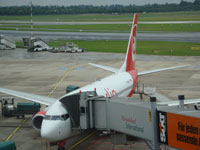 On Friday we flew from Paris to Munich to begin the Germany section of the trip. The flights had been booked for us, and we got to take Air Berlin (check out the picture). I was very impressed by this low-cost European carrier, and will certainly fly them any time I can in the future. Upon arrival, we got checked into our hostel and only had a few hours remaining in the day. A few friends and I headed straight for the city center of Munich, known as Marienplatz. It was definitely the liveliest area in the city, and had a lot of things to see and do. After a nice dinner we headed back to our comfortable room to get prepared for the next day.
On Friday we flew from Paris to Munich to begin the Germany section of the trip. The flights had been booked for us, and we got to take Air Berlin (check out the picture). I was very impressed by this low-cost European carrier, and will certainly fly them any time I can in the future. Upon arrival, we got checked into our hostel and only had a few hours remaining in the day. A few friends and I headed straight for the city center of Munich, known as Marienplatz. It was definitely the liveliest area in the city, and had a lot of things to see and do. After a nice dinner we headed back to our comfortable room to get prepared for the next day.
Saturday (July 11) was our big workday while in Munich. That morning we went out to the Deutches Museum northwest of Munich that is dedicated to aviation. The museum had a lot of interesting aircraft and information. Some of my favorite displays were the agricultural-use aircraft, as it showed a different side of aviation we had not yet discovered. Another cool display was not an aircraft at all, but rather an experiment. There was a propeller driven by pedals that, when gaining enough speed, would move the seat around in a circle (see picture). This was a very cool way to learn about how propellers work, and provided our group with a reason to lose concentration for about 30 minutes.
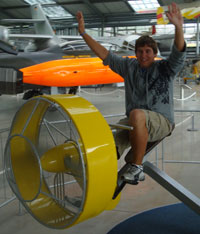 Saturday afternoon, we headed back into central Munich to the main Deutches Museum building, which included airplanes but had also many other displays. At this museum, we got to see many different military aircraft from Germany. Also, there was a Lufthansa Boeing 707 cockpit that you could see into. It is very cool to notice the huge differences in cockpits from many years ago when compared to cockpits of today. Another interesting display was the section on German air traffic control. Aside from the aviation part of the museum, we were encouraged to stay after the session and check out the rest of the exhibits. This museum was certainly one of my favorites and housed exhibits on nearly any technological advancement you could imagine. Some things covered were aviation, space exploration, boating and navigation, nuclear energy, computers, assembly lines, robotics, and thousands of other items. The never-ending array of information was fascinating, and I could have spent a much longer time at the Deutches Museum.
Saturday afternoon, we headed back into central Munich to the main Deutches Museum building, which included airplanes but had also many other displays. At this museum, we got to see many different military aircraft from Germany. Also, there was a Lufthansa Boeing 707 cockpit that you could see into. It is very cool to notice the huge differences in cockpits from many years ago when compared to cockpits of today. Another interesting display was the section on German air traffic control. Aside from the aviation part of the museum, we were encouraged to stay after the session and check out the rest of the exhibits. This museum was certainly one of my favorites and housed exhibits on nearly any technological advancement you could imagine. Some things covered were aviation, space exploration, boating and navigation, nuclear energy, computers, assembly lines, robotics, and thousands of other items. The never-ending array of information was fascinating, and I could have spent a much longer time at the Deutches Museum.
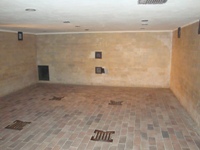 After a long Saturday of work, we were rewarded with a free day to end the weekend. I started my day on a free walking tour and saw a lot of the city. Some of the better sites included the Hofbrahaus, Glockenspiel, Frauenkirche, Mozart’s temporary home, and the City Hall. Although those sites were quite breathtaking, they didn’t even compare to what I was about to experience. That afternoon I hopped on a train and decided to visit the Dachau Concentration Camp outside of Munich. From the moment I arrived I felt the power of such a devastating place. The barracks, the showers, the washrooms, and the museum were almost too much to handle. And then, when I thought I had seen it all, we stepped into the gas chamber and crematorium. The entire time I visited the site I couldn’t help but feel saddened by certainly one of the low points of the human race. However, it was quite a sobering experience, and I certainly will never forget how I felt and what I saw at Dachau.
After a long Saturday of work, we were rewarded with a free day to end the weekend. I started my day on a free walking tour and saw a lot of the city. Some of the better sites included the Hofbrahaus, Glockenspiel, Frauenkirche, Mozart’s temporary home, and the City Hall. Although those sites were quite breathtaking, they didn’t even compare to what I was about to experience. That afternoon I hopped on a train and decided to visit the Dachau Concentration Camp outside of Munich. From the moment I arrived I felt the power of such a devastating place. The barracks, the showers, the washrooms, and the museum were almost too much to handle. And then, when I thought I had seen it all, we stepped into the gas chamber and crematorium. The entire time I visited the site I couldn’t help but feel saddened by certainly one of the low points of the human race. However, it was quite a sobering experience, and I certainly will never forget how I felt and what I saw at Dachau.
 Munich has been a great way to begin our visit in Germany. I have really enjoyed the city’s liveliness and culture. The German language is very different, but I am having fun trying to use some of what I learned prior to leaving. I am excited to head out to Traben-Trarbach, where our group will take a glider flight. I hope you have enjoyed my Europe journals, and if you have any questions about the trip or something else, email me at meansm@erau.edu. Thanks for reading.
Munich has been a great way to begin our visit in Germany. I have really enjoyed the city’s liveliness and culture. The German language is very different, but I am having fun trying to use some of what I learned prior to leaving. I am excited to head out to Traben-Trarbach, where our group will take a glider flight. I hope you have enjoyed my Europe journals, and if you have any questions about the trip or something else, email me at meansm@erau.edu. Thanks for reading.
Tchüss from Deutschland,
Mack


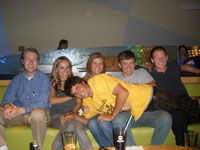 Lately I’ve been working on a solar array sizing program. I never really liked programming before, but actually applying it to things that I’m interested in is actually pretty cool. In the program, you input the power loads (how much power the instruments need) and some other information which is specific to the satellite such as orbit altitude, and what you want to make your solar array and batteries out of. Then it spits out answers like how big your solar array needs to be, how many batteries are required and the eclipse and sunlight exposure times. I’m still working out a few final input error checks and the form the user fills out, but I’m excited to see my final product!
Lately I’ve been working on a solar array sizing program. I never really liked programming before, but actually applying it to things that I’m interested in is actually pretty cool. In the program, you input the power loads (how much power the instruments need) and some other information which is specific to the satellite such as orbit altitude, and what you want to make your solar array and batteries out of. Then it spits out answers like how big your solar array needs to be, how many batteries are required and the eclipse and sunlight exposure times. I’m still working out a few final input error checks and the form the user fills out, but I’m excited to see my final product!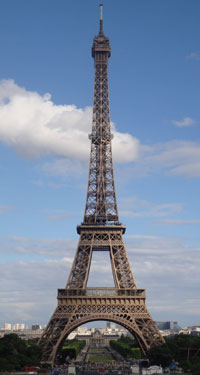 After the fast train ride we checked into our hotel and headed to the Louvre for a group cultural experience. The Louvre displays sucha wide variety of works of art from all different time periods andplaces all over the world. It’s a bit overwhelming to try to grip theimportance and historical value of everything you see. A few of thethousands exhibits included Michelangelo’s Dying Slave and Da Vinci’s Mona Lisa. I really appreciate the effort of Professor Kirton to make the cultural events part of the course. Not only have I learned a lot about aviation, but also I have broadened my global thinking.
After the fast train ride we checked into our hotel and headed to the Louvre for a group cultural experience. The Louvre displays sucha wide variety of works of art from all different time periods andplaces all over the world. It’s a bit overwhelming to try to grip theimportance and historical value of everything you see. A few of thethousands exhibits included Michelangelo’s Dying Slave and Da Vinci’s Mona Lisa. I really appreciate the effort of Professor Kirton to make the cultural events part of the course. Not only have I learned a lot about aviation, but also I have broadened my global thinking.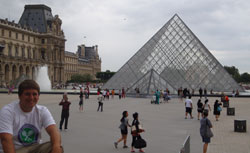 Thursday was our free day at Paris, and we accomplished a lot. A group of five of us visited Notre Dame, the Sacre Couer, Centre Pompidou, and the top of the Eiffel Tower. Each attraction was a little different, but I found all of them very interesting. Although they are quite close geographically, the cities of Paris and London feel worlds apart. I love both of them, but I still believe London ranks higher for me. Tomorrow however, we are switching it up again as we fly to Munich to begin our German section of the trip.
Thursday was our free day at Paris, and we accomplished a lot. A group of five of us visited Notre Dame, the Sacre Couer, Centre Pompidou, and the top of the Eiffel Tower. Each attraction was a little different, but I found all of them very interesting. Although they are quite close geographically, the cities of Paris and London feel worlds apart. I love both of them, but I still believe London ranks higher for me. Tomorrow however, we are switching it up again as we fly to Munich to begin our German section of the trip. The afternoon of our arrival (July 2), we all met at the British Science Museum for our first session. The museum has a great display of all different types of aircraft and parts. One of the most interesting planes was the Vickers Vimy (pictured), which was the first plane to cross the Atlantic Ocean. It was a larger plane for its day, and had some pretty impressive specifications. My other favorite display was a cross section cut out of a British Airways 747 jet. It interested me greatly to see all of the inner workings of the commercial aircraft. The next day (July 3), we headed off to the Imperial War Museum north of London. The train and bus rides to Duxford took a little while, but the wait was well worth it. My true love of aviation is in commercial aviation, and this museum had many commercial displays. I really enjoyed the British Oversees Airways Corporation (BOAC) BAC-VC10. I had never heard or read too much about this aircraft, but it was much bulkier than I expected it to be from pictures. It was like an MD82 on steroids with two extra engines. It was very different looking, but still very cool. Another plane I was surprised to see in Duxford was the Concorde.
The afternoon of our arrival (July 2), we all met at the British Science Museum for our first session. The museum has a great display of all different types of aircraft and parts. One of the most interesting planes was the Vickers Vimy (pictured), which was the first plane to cross the Atlantic Ocean. It was a larger plane for its day, and had some pretty impressive specifications. My other favorite display was a cross section cut out of a British Airways 747 jet. It interested me greatly to see all of the inner workings of the commercial aircraft. The next day (July 3), we headed off to the Imperial War Museum north of London. The train and bus rides to Duxford took a little while, but the wait was well worth it. My true love of aviation is in commercial aviation, and this museum had many commercial displays. I really enjoyed the British Oversees Airways Corporation (BOAC) BAC-VC10. I had never heard or read too much about this aircraft, but it was much bulkier than I expected it to be from pictures. It was like an MD82 on steroids with two extra engines. It was very different looking, but still very cool. Another plane I was surprised to see in Duxford was the Concorde.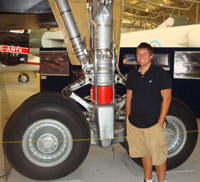 (Check out the picture of me by the Concord landing gear!) The exact Concorde at the Museum was never used commercially, but was one of the testing planes used by the production company. In its testing it had set the record speed and the record transatlantic flight time for all the Concords. Also in this museum was a de Havilland Comet 4, B52 bomber, and tons of other really neat planes. The Imperial War Museum was definitely my favorite in England. Saturday (July 4) came and we were off to the Royal Air Force Museum in Hendon. Although military aviation interests me less, it was still top-notch. The displays in the museum were very interactive and held tons of good information. A lot of information was always appreciated as part of our work included filling out information sheets on aircraft and how they affected aviation and the world. With the information sheets completed we would gather and do short presentations on our favorite planes. This was an effective and simple way to grasp an understanding of how important these planes were to their country’s development and protection.
(Check out the picture of me by the Concord landing gear!) The exact Concorde at the Museum was never used commercially, but was one of the testing planes used by the production company. In its testing it had set the record speed and the record transatlantic flight time for all the Concords. Also in this museum was a de Havilland Comet 4, B52 bomber, and tons of other really neat planes. The Imperial War Museum was definitely my favorite in England. Saturday (July 4) came and we were off to the Royal Air Force Museum in Hendon. Although military aviation interests me less, it was still top-notch. The displays in the museum were very interactive and held tons of good information. A lot of information was always appreciated as part of our work included filling out information sheets on aircraft and how they affected aviation and the world. With the information sheets completed we would gather and do short presentations on our favorite planes. This was an effective and simple way to grasp an understanding of how important these planes were to their country’s development and protection.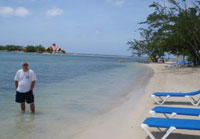
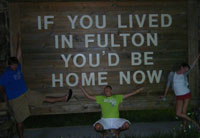

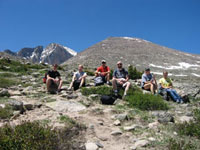

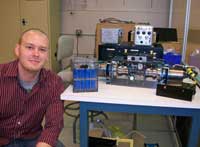 “Hello, world!” My name is Geoff Bruder, and I am a senior in Aerospace Engineering with an Astronautics concentration at Embry-Riddle’s Daytona Beach campus. Since this is my first post, I’ll give you a little of my background and tell you some of the great things I have been able to do thanks to Embry-Riddle.
“Hello, world!” My name is Geoff Bruder, and I am a senior in Aerospace Engineering with an Astronautics concentration at Embry-Riddle’s Daytona Beach campus. Since this is my first post, I’ll give you a little of my background and tell you some of the great things I have been able to do thanks to Embry-Riddle.